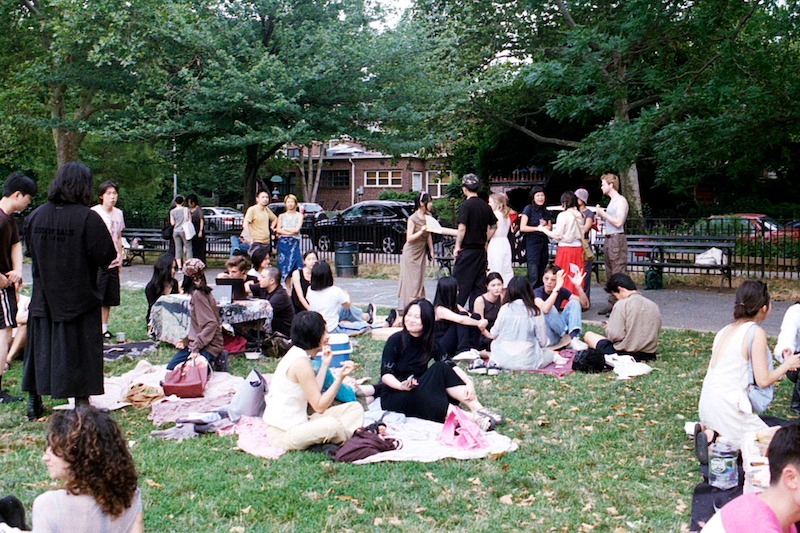Seoyoung Kim’s Site Centers Empathy and Connectivity
On July 20, 2024, Site—a platform offering “a variable experience and curation service”—presented a one-day pop-up exhibition titled Grass Stains at an unusual open-air location: Cooper Park in Brooklyn. Artworks are nestled on the uneven grass field, atop picnic blankets, and even hanging from a tree. Challenging the austerity of art establishments, the wall-less exhibition, like the curatorial initiative’s name, plays with land art pioneer Robert Smithson’s postulation of “site” and “non-site” in the 1960s.
Site’s founding director and lead curator, Seoyoung Kim (b. 1999, Seoul), is a New York-based interdisciplinary artist. When she first came to the US in 2018 to attend RISD (Rhode Island School of Design), she hoped to experiment with a wide range of media, including graphic design and film. Now, as her practice continues to evolve, her sculptural paintings tap into a conversation with physical realities and spatial relationships.
When the pandemic hit, Kim decided to take a year off to stay in Seoul, which was when she first dabbled in curation and working with project spaces. Kim recalls: “I couldn't find a suitable artist studio. The rent in Seoul was pretty bad. I was thinking to myself: ‘Should I just paint in my parents’ kitchen?’” Serendipitously, she soon found an abandoned basement warehouse in an unrenovated residential building: “It was dirt cheap and too good to pass on. If I split everything up, I'd be able to rent it out to other artists.” She did exactly that. Inviting friends and fellow artists, Kim later organized open studios to bring together an art community at a time of global isolation. “The lease was only for a year,” she says, “so towards the end of that lease, I thought I might as well put up a show.” Kim calls her approach in Seoul “internal” and titled the makeshift curatorial initiative Projectspace WIP to reflect its down-to-earth and collaborative nature. Kim notes: “Frieze Seoul, a recent addition to the art world in Korea, has allowed for an impressive rise in the commercial art scene there. In the meantime, alternative spaces are also on the rise. I’m always keeping an eye out for the alternative and project spaces back home that are following a non-white-cube format.”
After moving to New York upon graduation, Kim was offered art administration roles at the NARS Foundation and Trellis Art Fund: “Gaining more perspective from an institutional point of view has been incredibly helpful for me, as I am discovering new artists and understanding what they want, what their ambitions are, and how they want to launch their careers in New York.” Along with Kim’s own journey, Projectspace WIP turned into Site, a safe space for emerging artists. Remarking on Site’s mission, Kim says: “As artists, we always have this pressure of selling artworks, putting together a CV, and networking to be able to make a living with our practice. As an art school graduate, I realized it’s not always easy navigating the major commercial galleries in Chelsea or Tribeca. That said, there’s an alternative art scene that balances out the commercial world, and sometimes there are beautiful intersections between the two. At Site, I wanted to return to the origin of why we create art and just let our artists connect in a comfortable, vibrant environment.”
Since its inaugural show in February of this year, Site has garnered strong communal support. Kim now devotes much of her time to studio visits, engaging with artists’ works with an open and curious mind: “I love it when artists cannot stop talking about their art. Learning from them also brings great synergy to my art practice, because for me, curation and artmaking cannot exist independently from each other.” That said, she is still grappling with the evolving definition of curation: “Coming from an artist background, I don’t really identify as a curator, and I’m still trying to define what curating means to me. Right now, I think of myself as an ‘organizer’ of sorts and prioritize the artists’ practice. The most important mission is that the artists are happy with their show, and we build a community where we can just enjoy each other’s presence.”
Thus far, Site’s exhibitions have been nomadic and pop-up by nature, lasting 1–2 days each, but as the initiative starts to grow, Kim hopes to organize longer-term exhibitions that allow artists to “dig deeper” and give viewers more to engage with the artworks. Centering empathy and connectivity, Seoyoung Kim is only getting started.
You Might Also Like:
A Celebration of Being and Balance




